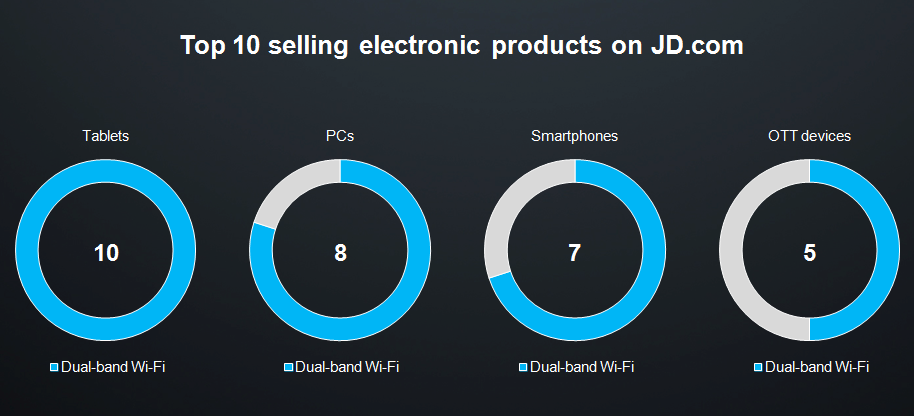High-quality Dual-band Wi-Fi Gateways Are Urgently Needed to Improve Home Broadband Experience
Under China's "Internet+", new services such as 4K HD videos, virtual reality (VR), and smart home are prompting operators to continuously upgrade bandwidth. In China, broadband users are enjoying 100 Mbit/s and some are even experiencing 1000 Mbit/s. At present, China's top 3 operators rarely provide service packages with bandwidth lower than 100 Mbit/s. In some developed provinces, operators even offer bandwidth starting from 100 Mbit/s and also incorporate 100 Mbit/s Wi-Fi services in their service packages.
Wi-Fi has been the standard interface for home terminals, including smartphones, tablets, set-top boxes (STBs), surveillance cameras, and smart home appliances distributed throughout a household, from the living room to the bedroom and from the kitchen to the balcony.
Statistics show that in a China's household, 6 terminals are connected through Wi-Fi on average and more than 90% users enjoy video on demand (VoD) through Wi-Fi. Broadband operators are well aware of the significance of Wi-Fi quality for broadband services. If Wi-Fi rates are inconsistent with the rates specified in broadband packages, users' service experience will be greatly affected.
Wi-Fi Gateways Need to be Moved Outside Network Boxes
Wi-Fi technologies have brought convenience to users, but they have some disadvantages. Especially during the fiber to the home (FTTH) deployment in China, terminal gateways are mostly deployed in home network boxes, affecting Wi-Fi performance to some extent.
- Wi-Fi signals are attenuated and their performance deteriorates when passing through obstacles, such as walls or special glass.
- In most households, gateways are placed in unsuitable positions, affecting Wi-Fi coverage. For example, home gateways may be deployed in network boxes or sealed storage rooms, greatly attenuating Wi-Fi signals at 2.4 GHz and 5 GHz bands.
Therefore, it is recommended that gateways with Wi-Fi function be moved outside network boxes; instead, invisible fiber routing should be used to deploy the gateways on desks or open areas without obstacles.
The industry already has a mature invisible fiber routing solution for deploying gateways indoors. In this solution, a skilled engineer can complete fiber routing in a household within 30 minutes. Moreover, the fiber routing does not affect users' home decoration, so it is more likely to be accepted by users.
Dual-band Wi-Fi Is the Mainstream Configuration in the Market
(1) All Consumer Electronic Products Are Configured with Dual-band Wi-Fi
For consumer electronic products, such as tablets, smartphones, PCs, and over the top (OTT) devices, the proportion of delivered products that support dual-band Wi-Fi is increasing, making dual-band Wi-Fi the mainstream configuration. In terms of the selection of home network terminals, dual-band gateways are recommended to achieve the best network performance.

(2) Global Mainstream Operators Choose High-quality Dual-band Gateways
The world's leading operators are gradually beginning to incorporate their FTTH services with high-speed Wi-Fi. For example, America's Comcast XFINITY releases FTTH services that boast a rate of 725 Mbit/s. Verizon Fios, the largest competitor to Comcast XFINITY also launches Wi-Fi services at a rate of 800 Mbit/s intended for home users and claims that the 800 Mbit/s Wi-Fi package is the fastest home Wi-Fi package.
After delivering home bandwidth of 500 Mbit/s, BT requires suppliers to provide 500 Mbit/s @ anywhere solution that is based on IEEE 802.11ax.
Additionally, dual-band gateways accounted for more than 50% of China Telecom and China Mobile's terminal procurement. These gateways help to comprehensively improve service quality.
(3) Dual-band Wi-Fi Supports Better Video Bearing
There are multiple Wi-Fi standards. Current mainstream gateways comply with the IEEE 802.11n standard and use 2 x 2 multiple-input multiple-output (MIMO) Wi-Fi interfaces that work in the 2.4 GHz band. According to this standard, the maximum air interface rate is 300 Mbit/s and the Ethernet throughput rate is lower than 140 Mbit/s.
The IEEE 802.11ac is a new-generation Wi-Fi standard that works in 2.4 GHz or 5 GHz band. In mainstream configurations of this standard, 2.4 GHz 2 x 2 MIMO and 5 GHz 2 x 2 MIMO are used, delivering a maximum air interface rate of 1166 Mbit/s and throughput rate of 500–600 Mbit/s. Compared with the gateways working at the 2.4 GHz band based on the IEEE 802.11n, dual-band Wi-Fi gateways provide a larger number of channels, stronger anti-interference capacity, higher rate, and shorter latency to better support high-speed Wi-Fi services such as HD videos.

When the actual home environment is simulated (such as test scenario 2), in a house that has common Wi-Fi interferences, if a dual-band Wi-Fi gateway is used, HD and 4K videos carried over the 5 GHz band do not encounter any erratic display, perfectly accommodating video development.
Distributed Home APs Help Dual-band Gateways Deliver the Best Performance
For high-value customers or those who live in large houses or villas, a single dual-band gateway cannot provide sufficient Wi-Fi coverage to ensure good service experience. In the new era of home broadband development, operators are actively improving their service quality and providing differentiated solutions.
For example, a Chinese operator has begun to deploy "smart network" services across the entire country. By using 1 smart dual-band gateway and multiple distributed access points (APs), this operator extends ultra broadband (UBB) to every corner of a house through existing Ethernet cables, power cables, or Wi-Fi. Therefore, users can enjoy bandwidth higher than 100 Mbit/s in any room of their house.
Moreover, through intelligent synchronization of network configurations and seamless roaming of terminals, users do not need to implement complex configurations such as Wi-Fi passwords. This improves their service experience, enabling better Wi-Fi coverage and more stable and high-speed Internet surfing.
Huawei's home network series solutions comprehensively support dual-band Wi-Fi and provide premium Wi-Fi performance for home users. These solutions have been deployed on a large scale by leading operators around the world, helping them achieve business success. Huawei will continue to make innovations to improve users' broadband experience.